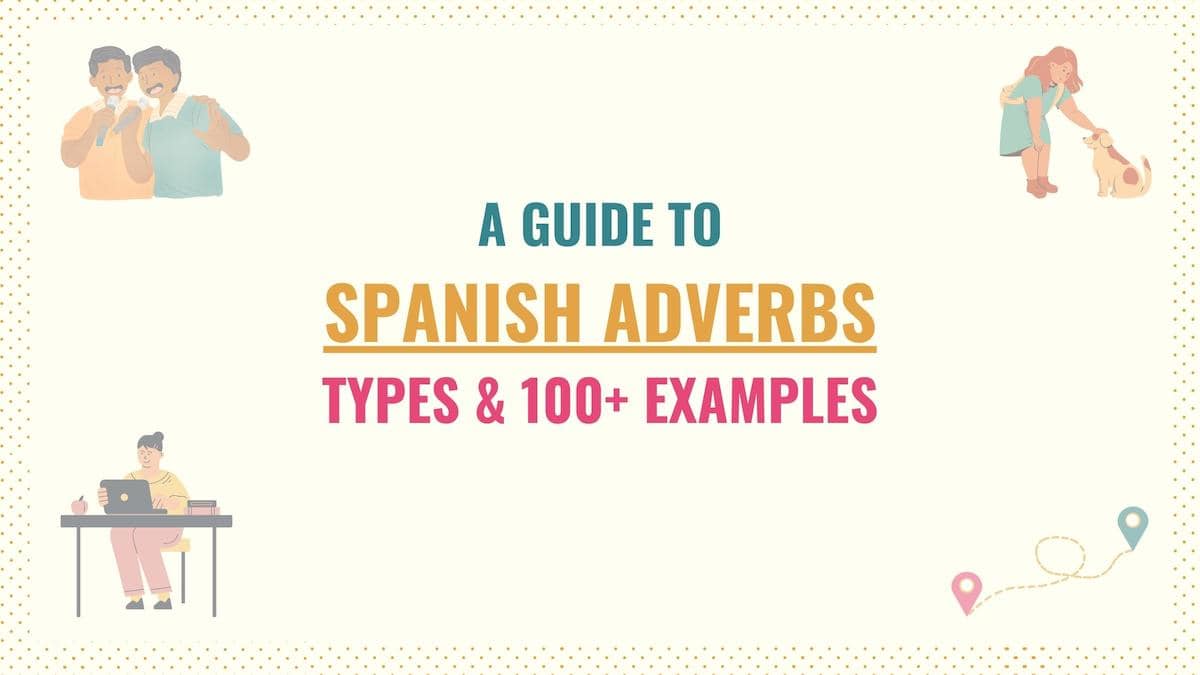Like adjectives, Spanish adverbs are one of the parts of speech that make your sentences more clear and descriptive. So, in short, adverbs are a must when learning Spanish.
For that reason, in this guide, you’ll find key information about how these words work along with a list of over 100 basic adverbs you should include in your vocabulary immediately! Here is what we’ll cover:
- What Are Adverbs & How Do They Work?
- Types of Adverbs & Examples
- Forming Adverbs (-mente Adverbs in Spanish)
- Bonus: Common Adverbial Phrases
- Key Points
- Downloadable PDF
So, let’s get started!
What Is an Adverb?
A Spanish adverb is a word that provides additional information about the verb. In other words, they describe the time, manner, frequency, or place an action takes place. They also intensify the characteristics described by an adjective or another adverb.
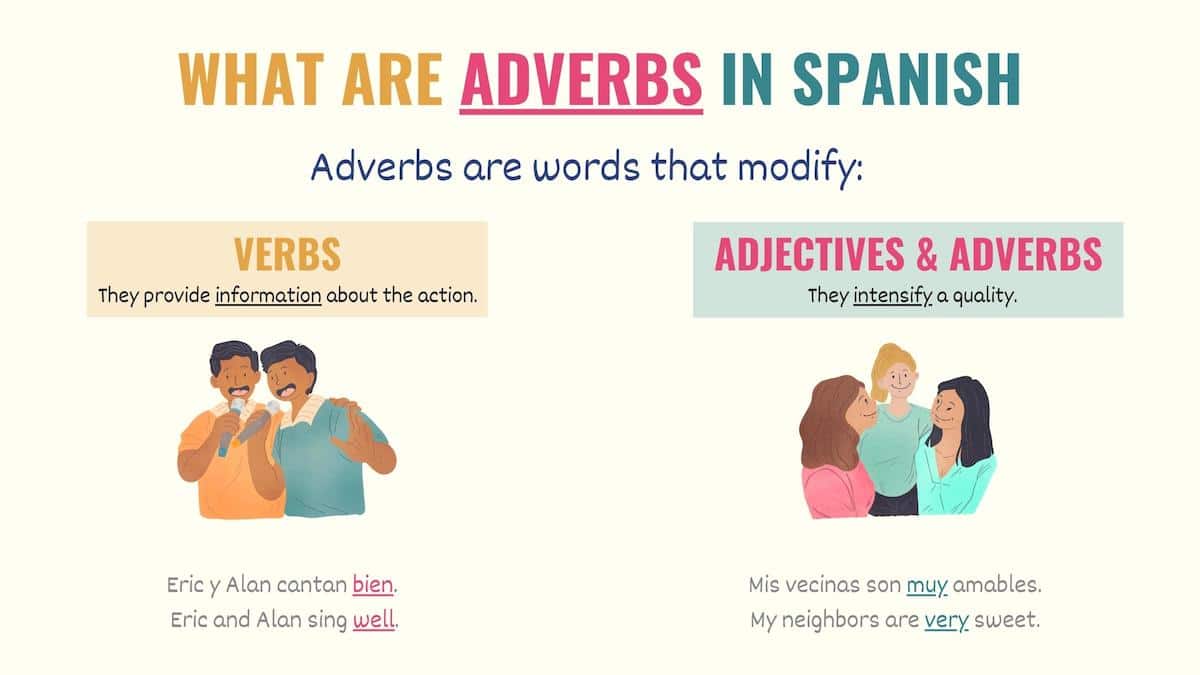
These words have a simple function: modifying a verb, an adjective, or another adverb. Simply put, we use these words to give extra details about the circumstances surrounding an action. For example:
Yo llegué temprano.
I arrived early.
In this example, temprano is an adverb that tells you more information about my arrival.
On top of describing verbs, an adverb can also intensify the qualities of an adjective or another adverb. In this case, adverbs are placed before the word they’re modifying.
Tu camisa es muy bonita.
Your shirt is very pretty.
¿Por qué comes tan lento?
Why do you eat so slowly?
As we’ll learn in the sections below, adverbs are classified based on the information they convey.
Spanish Adverb Types
As established before, Spanish adverbs provide additional information about the circumstances surrounding the action. Based on their meaning, there are four main types of adverbs in Spanish:
- Time
- Place or location
- Manner
- Quantity or degree
In the sections below, you’ll find some examples of these words.
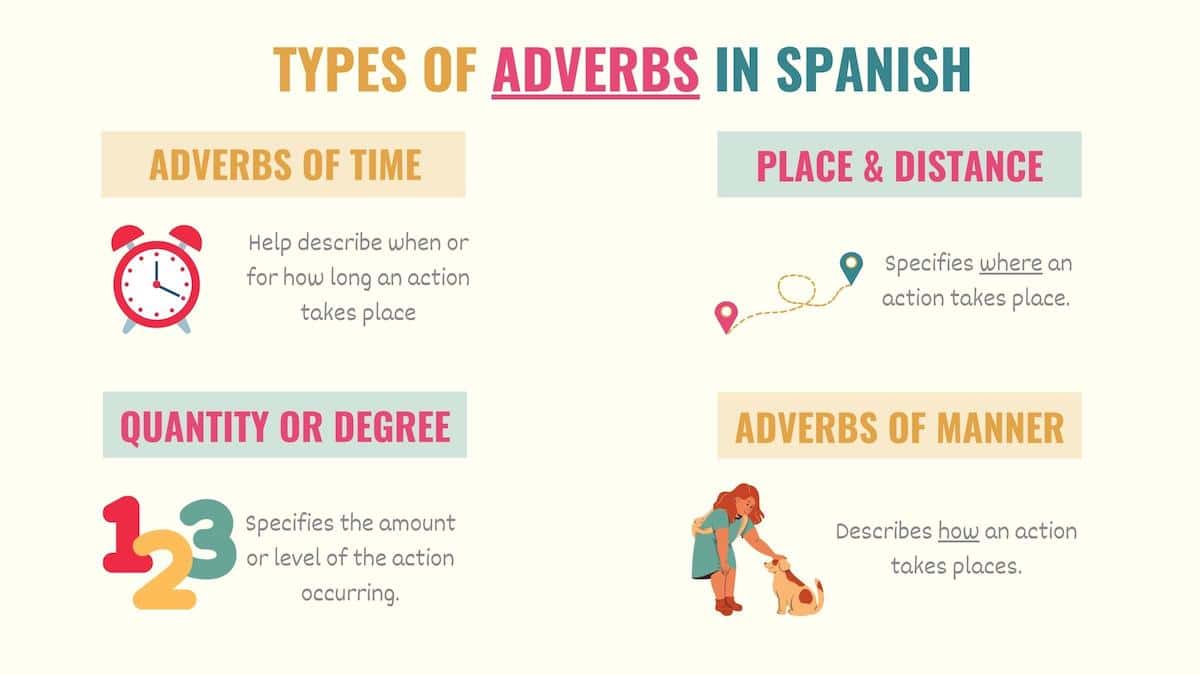
Tip: Depending on the course or book you use, you may find more classifications. However, these subcategories fit into one of the main categories listed above.
Adverbs of time in Spanish
Adverbs of time help you place when or for how long an action takes place. These adverbs are time markers, and we use them along with verb tenses.
Below is a list of the most common of adverbs of time are:
- Actualmente: currently
- Ahora: now
- Anoche: last night
- Antes: before
- Antier / Anteayer: the day before yesterday
- Anualmente: yearly
- Aún: still
- Ayer: yesterday
- Bastante: quite a while
- Cuando: when
- Después: after / then
- Durante: during
- Entonces: then / so
- Hoy: today
- Luego: later
- Mañana: tomorrow
- Mensualmente: monthly
- Mientras: while / in the meantime
- Nunca: never
- Pronto: soon
- Semanalmente: weekly
- Siempre: always
- Tarde: late
- Temprano: early
- Todavía: still
- Ya: already
Here are some example sentences:
Salí temprano de la oficina.
I left the office early.
Mañana iré al dentista.
I’ll go to the dentist tomorrow.
Todavía no he terminado de comer.
I haven’t finished eating yet.
Take Note: In some cases, some of these words may fall into the subcategory adverbs of frequency, which tell you how often you did something (siempre, nunca, anualmente).
Adverbs of place & distance
Adverbs of place, or location, convey the location of the thing or person the verb is talking about. In simple words, they respond to the question “where?”. Here are some examples:
- Abajo: down / downstairs
- Acá: there / then
- Adentro: inside
- Afuera: outside
- Ahí: there / then
- Allá: there / over there / back in
- Aquí: here / over here
- Atrás: behind / back
- Cerca: near
- Delante: in front / opposite
- Encima: on top of
- Enfrente: in front of
- Lejos: far
El hospital está cerca.
The hospital is near.
Dejé el celular encima de la tele.
I left the phone on top of the TV.
Aquí hay lugar.
There’s room over here.
Take Note: Aquí, acá, allí and allá may seem similar, but in reality, they express different amounts of distance. You can check the difference between these words by clicking here.
Adverbs of manner
Adverbs of manner explain the way an action is done. They respond to the question “how?”. Below is a list of common adverbs of manner:
- Apenas: barely / as soon as / hardly
- Así: like this / thus / like that
- Bien: well
- Deprisa: fast / quickly
- Despacio: slowly
- Igual: the same / the same way
- Lento: slowly / slow
- Mal: bad / badly
- Mejor: better / advisable
- Muy: very
- Peor: worse
- Rápido: quickly / fast
Grace no se siente bien.
Grace doesn’t feel well.
No me hablas así.
Don’t talk to me like that.
Come despacio. No hay prisa.
Eat slowly. There’s no hurry.
Take Note: Many adverbs of manner come from an adjective. These are words ending with -mente, which you’ll learn how to form in the section below.
Adverbs of quantity and degree
As its name suggests, adverbs of quantity or degree help communicate the amount or level of something. These words can modify verbs, but they’re more frequently used with adjectives and other adverbs.
- Algo: some / a little
- Casi: almost / nearly
- Demasiado: too much
- Más: more
- Mucho: very much / a lot
- Muy: very / so / too
- Nada: at all / nothing at all
- Poco: not much / not at all
- Tan: so / such
- Tanto: so much / so long / so many
Te amo demasiado.
I love you so much.
Josie habla español muy bien.
Josie speaks Spanish very well.
¡No comas tanto, por favor!
Don’t eat so much, please!
Take Note: The purpose of these types of words is to increase or decrease the qualities of an adjective or adverb. Some of these words may also work as adjectives of quantity (mucho, tanto, demasiado). However, adverbs do not mark the number or gender of a word.
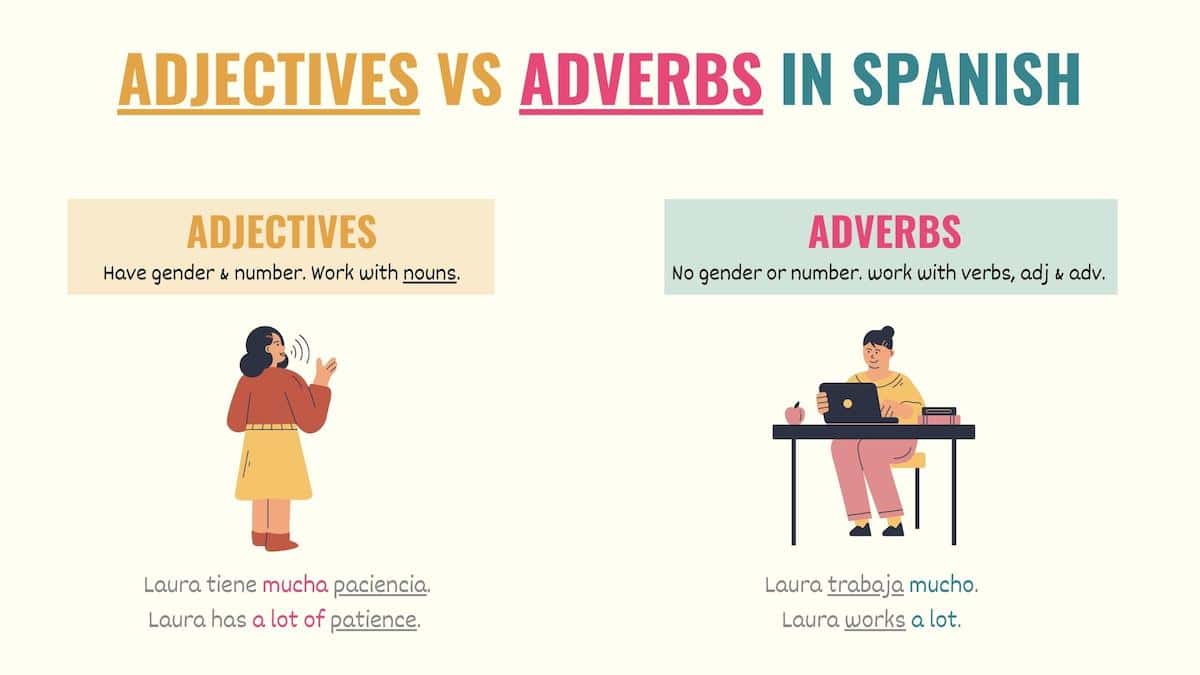
Turning Adjectives into Adverbs in Spanish
In Spanish, words ending with –mente are also adverbs and they’re formed from an adjective. To turn an adjective into an adverb, add the ending –mente to the feminine form of the adjective. Keep in mind that if the adjective has an accent mark, you would need to keep it.
Not all adjectives can become adverbs. Adjectives of nationality, colors, or physical appearance cannot be transformed.
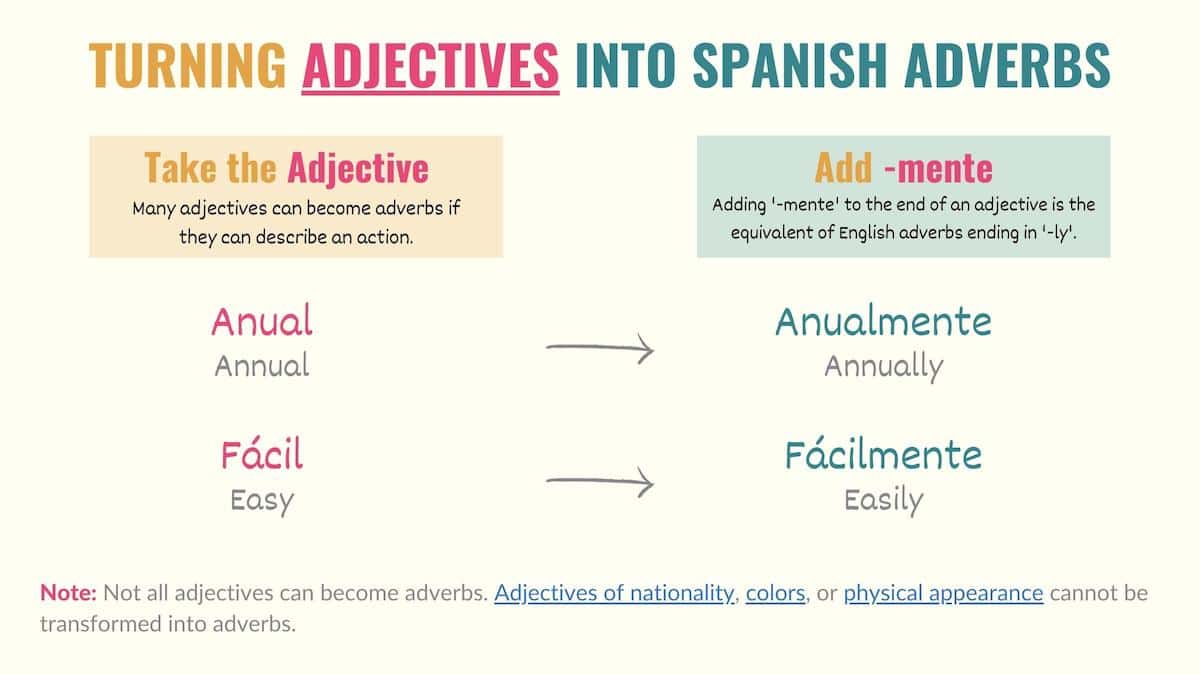
Here are some examples of common adverbs that are created by adding -mente to the end of adjectives. Notice that their English equivalent is words ending with ‘-ly’.
- Anualmente: annually
- Básicamente: basically
- Calmadamente: calmly
- Fácilmente: easily
- Felizmente: happily
- Fríamente: coldly / icily
- Difícilmente: hardly
- Mensualmente: monthly
- Lentamente: slowly
- Prácticamente: practically
- Rápidamente: quickly
- Regularmente: regularly
- Silenciosamente: quietly
- Solamente: only / solely
- Súbitamente: suddenly
Fácilmente, me gasté $1000 dólares.
I easily spent $1000 dollars.
Jon se fue súbita y silenciosamente.
Jon left suddenly and quietly.
Take Note: When using more than one adverb with -mente in a row, we must only add the ending to the last adverb in the list. Check the example above.
Like -mente, many patterns in Spanish can help you form words more easily. You can find these patterns for free in my Spanish Learning Kit.
Common Adverbial Phrases
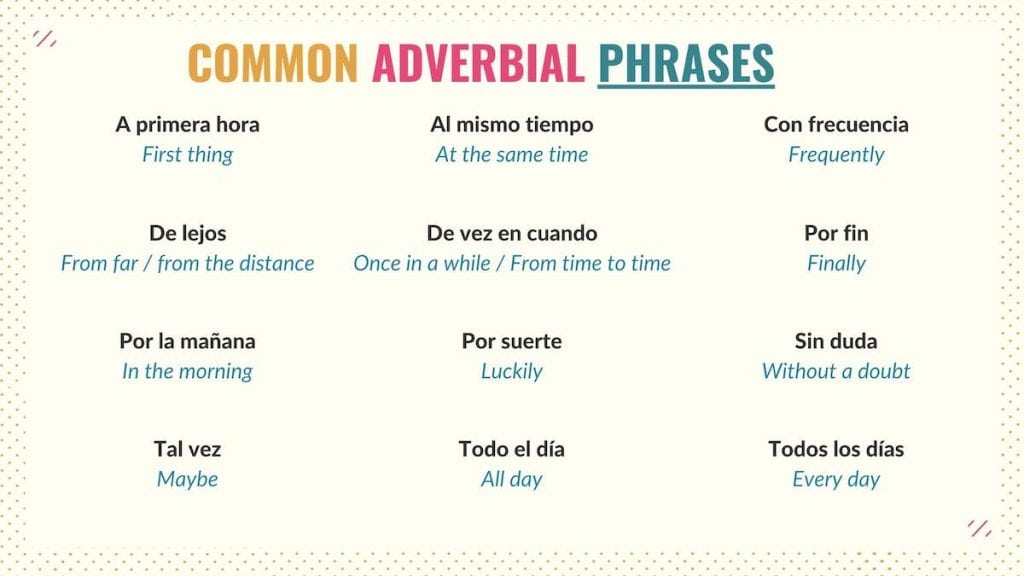
As you’ve learned so far, adverbs are words. However, there are also adverbial phrases that you can use to provide extra information about a verb, adjective or other adverb.
Here is a list of adverbial expressions you may want to learn:
- A primera hora: first thing
- A lo lejos: far away / in the distance
- A la derecha: to the right
- A la izquierda: to the left
- Al mismo tiempo: at the same time
- Al principio: in the beginning
- A veces: sometimes
- Así de fácil: that easy
- Con frecuencia: frequently
- De alguna manera: somehow
- De cerca: close up
- De día: during the day
- De lejos: from far / from the distance
- De repente / De pronto: suddenly
- De vez en cuando: once in a while / from time to time
- En realidad: actually
- Para nada: not at all
- Pasado mañana: the day after tomorrow
- Por fin: finally
- Por la mañana: in the morning
- Por la noche: at night
- Por otro lado: on the other hand
- Por suerte: luckily
- Sin duda: without a doubt
- Tal vez: maybe
- Todo el día: all day
- Todos los días: every day
- Todos los años: every year
A veces, jugábamos en el parque.
Sometimes, we played in the park.
Bill trabaja por la noche.
Bill works at night.
Take Note: Al + infinitive is used to build adverbial expressions of time. For example, al amanecer, al atardecer, al anochecer, etc.
Key Points
Since they deliver information about the action, Spanish adverbs are a crucial element in any descriptive sentence. Here are some key points you should keep in mind:
- Adverbs are a part of speech which modify a verb, adjective or another adverb.
- When modifying verbs, Spanish adverbs describe the circumstances surrounding the action.
- The most common types of adverbs are time, manner, place, and degree or quantity.
- In Spanish, adverbs of time work with verb tenses. These adverbs are what students know as trigger words or time markers.
- Adverbs increase or decrease the qualities expressed by an adjective or other adverbs.
- Spanish adverbs do not have gender or plural forms.
- Words ending in -mente are adverbs built from an adjective.
Now that you’ve learned how these words work and the lists of the most common adverbs in Spanish, you’re ready to start using these words in your conversations.
Download the Spanish Adverbs Cheat sheets PDF
Since adverbs are one of the fundamental types of words in Spanish and can take some time to learn the rules, types of adverbs as well as the various adverbs you’ll want to add to your vocabulary, I’ve created a PDF for this guide. Feel free to download a copy to study later as you practice your use of adverbs!
Related Spanish Grammar & Vocabulary Resources
Here are some of the next steps you should take if you want to boost your Spanish grammar. Parts of speech are the different types of words we use to form sentences (verbs, nouns, conjunctions, etc). Understanding how they work can help you avoid common mistakes and sound more natural.
Some of the words you learned in this guide pinpoint when an action took place. Getting familiar with verb tenses will allow you to match a Spanish adverb with their corresponding tense. Finally, make sure you know some common verbs, so you can pair these words with them.

